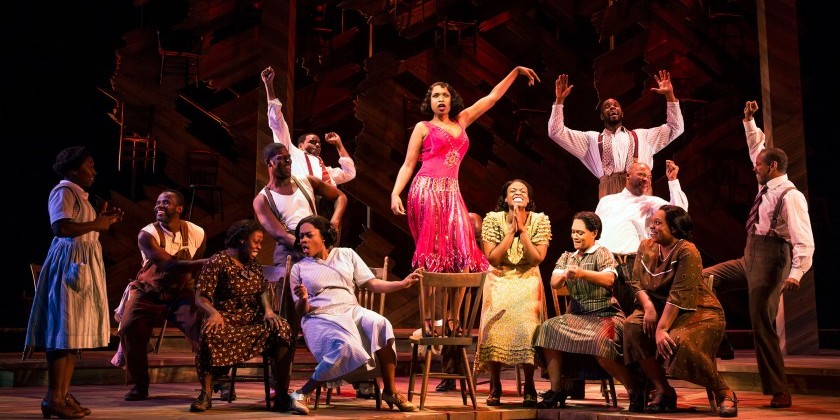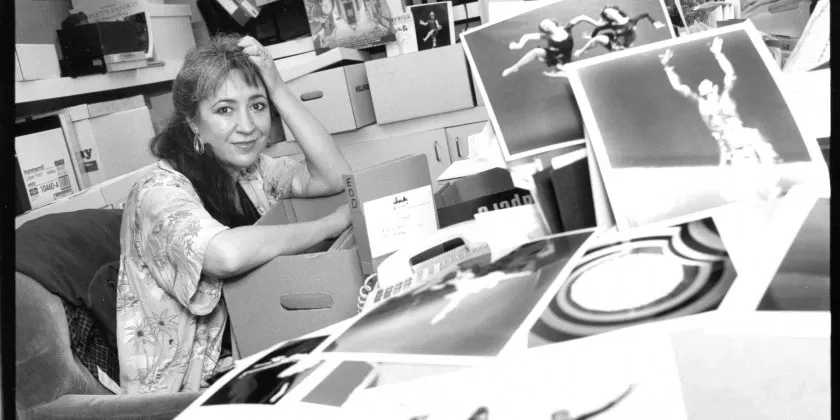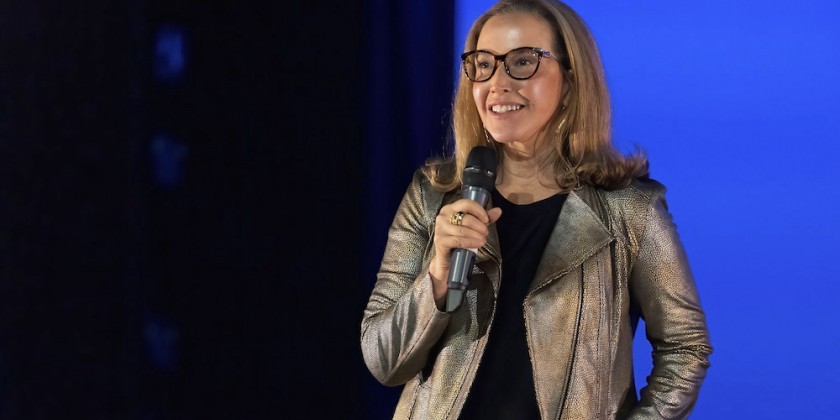Dance: Broadway Stage & Screen: Meet Sarita Lou Moore: From Dancer to "The Color Purple" on Broadway

Sarita Lou Moore, a graduate of UCLA World Arts and Cultures Program, has been living and working in New York City for the past seven years. Her professional life has been filled with copious dance classes; yoga instruction; choreographing (music videos, Off-Broadway productions, sometimes her own concert work); working on the moving aspects of art installations; and, even a creating web series, For The Love of Dance. Never in Moore’s wildest dreams did she believe that she would become the associate director of one of the most powerful musical revivals on Broadway today, The Color Purple.
I was fortunate enough to grab a few minutes with artist to talk about the delicious surprises that have led her journey thus far.--Christine Jowers, Editor of The Dance Enthusiast
Christine Jowers for The Dance Enthusiast: Did you always know that you wanted to dance Sarita, and did you suspect that you would choreograph, work with visual artists, create a video series, or end up working in directing theater?
Sarita Lou Moore: When you grow up as a dancer you think you have to be a dancer or NOTHING, but UCLA did a great job of educating us on the many career paths one could have to be vital in the arts, a person of the arts.
TDE: How did the transition from dancer to becoming a “person of the arts” begin?
SLM: One thing that defines my career path is the element of surprise and opportunity.
When I first arrived in New York City I took classes, mainly at Peridance and Dance New Amsterdam—lots of contemporary classes, Simonson Jazz — and a ton of yoga. But I didn’t audition at all. I was definitely scared to — not because of the choreography, or the setting, but because during my final year of UCLA I tore my psoas.
As much as I love dancing and performing, [because of this] I had this stop button that stopped me too soon, especially for an auditioner. A dance performer needs to be able to give it their all, and I didn’t feel confident that I wouldn’t re-injure myself so I held back. In retrospect, this was the key to my going into choreography sooner than I would have done, and I am so grateful.

TDE: And how did you start to work with actors?
SLM: It was a happy evolution. One of my yoga students asked if I ever considered working at an acting studio because of my bubbly personality, then another friend, who knew Jena Necrason, the head of the movement department at Stella Adler, introduced me. I was hired to teach yoga, but Jena mentioned that if I was interested in teaching other things at the school, I could start observing her class. So for the last six years I have been receiving an education in various movement theories, and have moved from teaching only yoga, to teaching an introductory program of movement for actors, with Jenna helping me to shape the curriculum.
As it happened our dance technique teacher left on a sabbatical and never came back! Now I teach the primary dance technique class while continuing my studies with Stella Adler’s master movement teachers, Joanie Evans and Joanne Edelman, who both excel at helping actors use their bodes as vessels for communication. And, they are so generous. For 30 years, their curriculum has been responding to actors and what has been missing in acting training.
TDE: Working with actors as opposed to dancers, what do you find to be the movement challenges?
SLM: It depends on the level of the actor. The beginners often need to learn “to fill” their body. That is something that dancers just understand. We have an innate spatial awareness from having twirled and leapt and rolled and we are not scared of inhabiting space. For a newer actor this is really challenging. Even if they are used to being in front of people, they tend to want to be smaller.

TDE: How do you help them?
SLM: I tell them, to “inhabit their body imagine: wide hips, wide shoulders, breathe 360 degrees into your diaphragm, really fill the space.” Frankly, the talented actors, the ones that you know will get work, will find that ability. But if that’s a huge block and stays a block, you probably are not going to act.
TDE: What do actors tend to be natural at?
SLM: Actors are so willing, they have an insane amount of bravery — a different kind of bravery to dancers. Dancers don’t necessarily emotionally connect to a piece unless that is required in the choreography, but those connections are how an actor learns. Movement must come from the inside out.
TDE: Does a quest for perfection ever get in the way—physical perfection or other kinds?
SLM: Young female actors are under lots of pressure to be physically “perfect,” but the training demands that you get out of your comfort zone. You're asked to be so many different people, in so many different kinds of bodies, in so many different exercises, that perfectionism will only hold you back, increasing your tension and inhibiting you. For an actor, the sooner you leave that perfectionist streak behind the better. Now the work ethic… you have to keep your hard work ethic, the same as with dance. In dance all this is trickier because there is a form that you need your body to fulfill, and this isn’t always so in acting.

TDE: Now for the million dollar question, how did you get involved with this awesome revival of The Color Purple?
SLM: I am still, [she sighs] whoooooooo, amazed! Broadway is about who you know. I guess that is how things happen. My friend, Adam Hunter who is usually John Doyle’s assistant director, recommended me. I know Adam because we worked together workshopping a musical which I had written called, A Host of Sparrows.
TDE: Speaking of surprises, you wrote a musical?
SLM: It is called A Host of Sparrows —that is what the word is for a group of sparrows. It is a historical coming of age story about a black woman in 1940’s St. Louis written with Harlem Renaissance poetry woven into the lyrics of the songs, and I love it.
I wrote, we had music for it, and the when we workshopped the piece, Adam Hunter was the director. He knows me. He’s seen some of my choreography, and he knows too that my primary job is working with actors. I am a believer that,“work begets work.” So at that point, while I was choreographing an Off-Broadway musical, Adam emailed me saying, “My friend is doing The Color Purple and your resume is perfect. I want to know if this interests you.”
I wrote him back an email filled with question marks and exclamation points, and then said, “Get me an interview!”
TDE: What is it like working with John Doyle? What is your role? By the way, I saw the production and was bowled over by the actors, the singing,and the story—the audience on my night clapped so hard it was as if we wouldn’t let Cynthia Erivo finish her song because we as a group needed to appreciate her.
SLM: You can imagine from seeing the show just being part of that process every day was phenomenal. John Doyle’s approach was less choreographic and more about rooted movement —movement that came from the time period and from people’s natural bodies. My job is to take the natural setting, the scene, and heighten it, just they way John did with the wall of chairs that make up the background of the play. That image serves to up the stakes and scale. You know, as an audience member, you are seeing a grand story, but in such a humble way.

John shapes the numbers. He is a director that feels comfortable doing so. Some directors direct and leave holes for the choreographers to come in. But John knew. He had the vision for everything he wanted, and then he asked me to come in and shape, heighten, shave and clean — but you don’t want to make anything "too" clean. Much of the work in that that kind of process is exploration, trying things, putting them in and then taking them out again. The exploration gives your body information. The actors performed some of the numbers with fans at one point, then in slow motion, as we figured out the balance of what worked. I was there to support John’s vision and to assist him, for which I am so grateful for because I have learned so much from watching him work.
TDE: After seeing the play, I became such a fan of Isaiah Johnson who plays “Mister.” Such a gifted performer, but when the time rolls around for applause, he doesn’t get as much as the women because his character —until he transforms at the end —is horrible to “Celie.” I felt a bit bad for him about that.
SLM: I think Isaiah Johnson is one of the best actors I have had the pleasure of working with. He came in all the time with questions, and I think perhaps even now, backstage, is still wondering about “Mister” and “Celie's" relationship. This keeps it fresh for him, as well as for the audience. He is always trying new things— not new lines, not adding words— it’s his approach. He remains curious.

TDE: What were rehearsals like?
SLM: We had eight hour days. Everyone was called all the time unless the scene was very small. When we were going to work on the opening of “Africa” [This is a scene where Celie finally receives the many letters her sister, Nettie, has sent over the years. Here Celie discovers that Nettie is alive and working with a missionary family in Africa, and that Celie’s two children who were given away, and thought to be lost forever, are alive and with Nettie.] people gathered around the piano to work on the details of the music for about an hour. It was so complex. We would sing the music and drill it in order to be able to take it “off book”. Then, we put the work “on feet,” placing people where we thought they would go while imagining the different levels on stage [that didn’t exist in the rehearsal room.]
John would start us out with an anecdote that shared an idea or a quality that he was going for. Our show takes place in the late1920’s and 30’s, so he spoke a lot about his experiences with his grandmother, always sharing something very personal. After he set the scene for us, mapped out blocking, and said something about the action he wanted, he would let he actors give it ago .
It’s building the bones and the nervous system of the play. We went nice and slow but we also moved efficiently. We didn’t run the whole play all the time. John Doyle is a brilliant director. He has been doing this work for 40 years and it felt like it. We knew we were all in really good hands.

TDE: So, what is next for you? A Host of Sparrows?
A: That is going to be a big, big musical with as many people in it as The Color Purple. For those type of productions to be done and done correctly, they need support and time. I have a co- writer and we work on it, we continue to rewrite, but I realize that this play will come out l come when I am successful, it won’t make me successful. Once I have proven myself, then I will pull it out of the drawer. We will probably do a reading this summer to keep it fresh, so that we still have the characters in mind. For now we are waiting patiently.
TDE: Finally, do you have any advice for upcoming actors or dancers?
SLM : I always tell my young actor students to find something that they are passionate about that is adjacent to the work they love to do. I have had opportunities come up that I never would have foreseen because of this. If I waited tables as a performing dancer, I don’t know where I would be right now. Find something right next to field you love. If you love acting, try voice and speech or try writing about acting. Stay right next to your passion, don’t go too far. You’ll be surprised by the opportunities.
TDE: I hope you can make it to our Enthusiastic Event on April 12.
Tuesday, April 12, 2016 from 6:15 PM to 9:00 PM
FOR MORE INFO ABOUT OUR SPECIAL GUEST PERFORMERS, PANELISTS, AND THIS ENTHUSIASTIC EVENT! CLICK HERE














